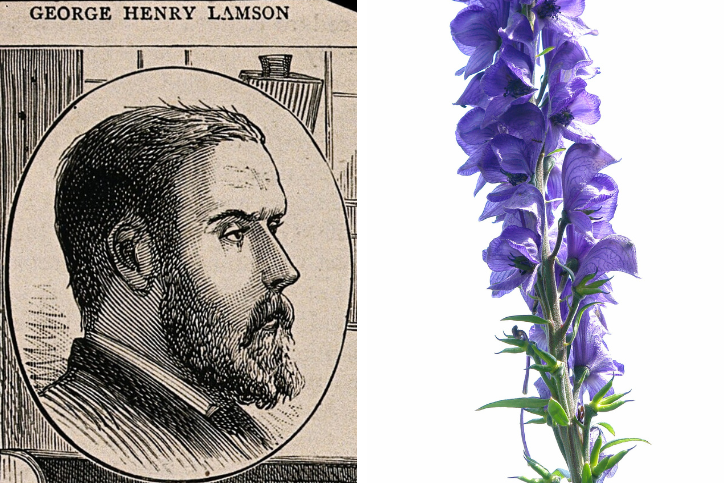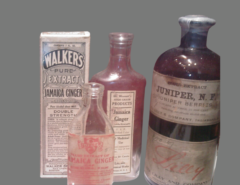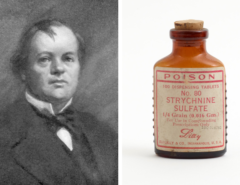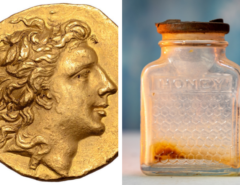*Disclaimer: This content is based on real historical events and includes sensitive language.
Aconite, a type of flowering plant, is often called the Queen of Poisons. This is an accurate description as it was used as a poison throughout history. In this edition of the Maryland Poison Center’s history series, we will look at the toxic history of aconite, a famous Victorian case involving it, and mishaps with it in today’s modern age.
What Aconite Does to the Body
Aconite interferes with sodium channels in the body. Sodium channels are present throughout the body, including in muscle cells and the brain. When sodium passes into a cell, it helps to generate an electrical signal which can eventually lead to actions like muscles contracting or chemicals being released between cells (neurotransmitters). Aconite causes an increase in sodium channel opening. The opening of sodium channels has effects on the muscles and the heart.
History of Aconite
In ancient mythology, it was believed that the aconite plant originated from Cerberus, the dog that guarded the underworld. Aconite is mentioned in the poem Metamorphoses, where the witch, Medea, is seeking to destroy the hero, Theseus, using an aconite mixture. According to the text, when Hercules pulled Cerberus (the multi-headed guard dog) from the underworld in chains, Cerberus was angry. The dog’s salvia fell on the nearby fields and rocks, growing into a plant later called aconite.
Dr. George Henry Lansom
Although Medea did not manage to destroy Theseus with aconite, this plant did not miss its mark for another famous poisoner – Dr. George Henry Lansom, a physician born in the United States in 1852. Lansom received numerous awards for his medical work, some during his time in the Franco-Prussian War (1870-1871). He married Kate George John in 1878 in England after the war. She had four siblings. The doctor had a morphine addiction that resulted from his time in service, and he was in debt.
In the 1870s any inheritance (property, money, etc.) a woman got from her family members passing went directly to her husband. Despite Lansom receiving the inheritance from his wife following the passing of her parents and several of her siblings, he was still deeply in debt. At the time, the remaining estate was divided among his wife Kate, her sister -the married Mrs. Chapman – and her youngest brother, Percy Malcom John. Lansom decided to murder his wife’s youngest brother, Percy Malcom John, to gain an additional portion of the previous inheritances.
Percy was partially paralyzed because of a curvature in his spine. He was a cheerful and beloved student, despite the difficulties of his condition. He was attending Blenheim House School at Wimbledon in London, England, when Lansom visited on Dec. 3, 1881, to meet with Percy and his teacher. He gave a pill capsule to Percy that night, which he took in front of his teacher. Lansom told the teacher that he brought the empty capsules as a gift to help the boys of the school take medicine. Dr. Lansom pretended to add sugar to the capsule for Percy to demonstrate how easy it was to swallow. He said to Percy: “Here, Percy, you are a swell pill taker; take this, and show Mr. Bedbrook how easily it may be swallowed.” The capsule contained something much worse than sugar!
Lansom left the school promptly after this exchange. Percy became sick later that evening. He was described by his teacher as being in terrible pain, complaining of his throat closing, “throwing himself about violently,” and vomiting. Despite care by doctors visiting the school, he died later that night within a few hours of taking the pill given to him by Lansom, his brother-in-law.
Lamson was put on trial for murder in March 1882 and was found guilty based on evidence that he purchased the poison – aconite – that killed Percy. He was sentenced to death, but his execution was delayed while his family attempted to demonstrate he was suffering from insanity. He was hung on April 28, 1882, at Wandsworth Prison at the age of 30.
Symptoms of Aconite Poisoning
People poisoned with aconite may experience:
- Tingling in the mouth, which may spread to other areas
- Drooling
- Nausea
- Vomiting
- Feeling of airway constriction
- Trouble swallowing or speaking
- Sweating
- Intense pain
- Changes in color vision (seeing yellow-green, or purple)
- Heart palpitations and changes in heart rhythm
- Decreased blood pressure
- Lack of coordination and fainting
- Muscle weakness and paralysis
Symptoms can be very severe and can occur rapidly, within 15-30 minutes of exposure.
Treatment of Aconite Poisoning
Aconite poisoning is treated in the hospital using fluids and medicines that treat nausea and vomiting, that increase heart rate (and help with drooling), and help correct heart rhythm. In patients where heart rhythm and blood pressure cannot be improved with medicine, mechanical circulatory support might be used.
Aconite Poisonings Today
Aconite poisoning still occurs today. It is a popular garden plant and used in some Chinese herbal medicines and other traditional medicines. Cases reported to Poison Centers in the United States sometimes arise from the improper use or preparation of traditional medications or teas. Occasionally it may be eaten by foragers who assume it is another edible plant (such as wild parsley or horseradish).
If you or someone you know have been exposed to aconite, please call your local poison center at 1-800-222-1222. This free and confidential service is available 24 hours a day, 7 days a week.
Amber Ferrell, PharmD
Certified Specialist in Poison Information





Leave a Reply